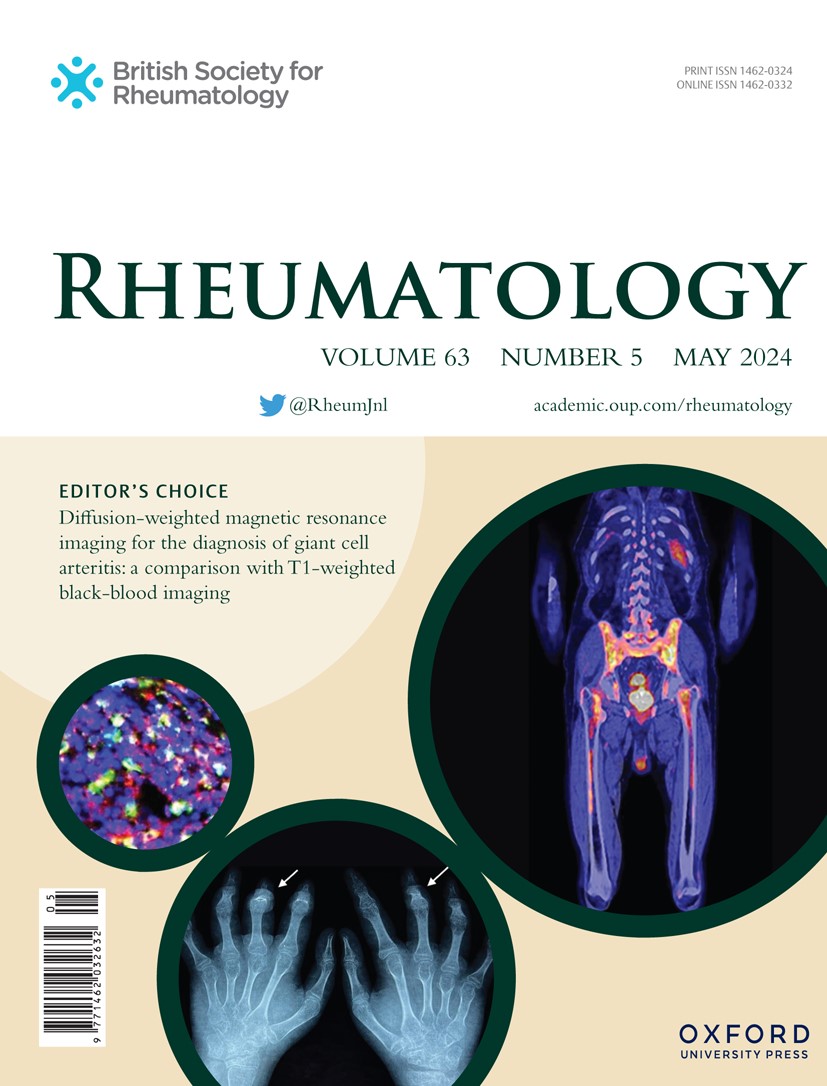羟氯喹停药治疗系统性红斑狼疮:一项3年随访的回顾性队列研究。
IF 4.4
2区 医学
Q1 RHEUMATOLOGY
引用次数: 0
摘要
目的评价羟氯喹(HCQ)停药后系统性红斑狼疮(SLE)发作的发生率及相关因素。方法:我们对停用HCQ的成年SLE患者进行了一项回顾性单中心研究。基线时(停药时间)的临床和血清学特征,在随访期间比较出现耀斑(任何、重复或严重)的患者和没有耀斑的患者,可能的观察期长达36个月。分类变量分析采用Fisher精确检验;使用基于正态性和方差的适当测试的连续变量。结果在纳入的42例患者中,分别有12例(29%)、15例(36%)和14例(38%)在第一年、第二年和第三年出现了急性发作。超过36个月,21例(50%)至少有一次耀斑,10例有严重耀斑,8例有重复耀斑。19例患者无耀斑。基线时低C3水平与任何耀斑(p< 0.001)、反复耀斑(p< 0.001)和严重耀斑(p= 0.014)相关。基线时C3较低的患者比C3正常的患者更早、更频繁地发作(log-rank p< 0.001),发作的危险比为10.18 (95%CI: 3.26-31.84, p< 0.001)。其他临床和实验室因素与预防耀斑无关。结论停用HCQ的患者中有一半在两年内发作。基线时C3水平低与耀斑风险增加相关。这些研究结果表明,在停药后不久,耀斑很常见,低C3可能有助于识别停药后疾病再激活风险较高的患者。本文章由计算机程序翻译,如有差异,请以英文原文为准。
Hydroxychloroquine discontinuation in systemic lupus erythematosus: a retrospective cohort study with 3-year follow-up.
OBJECTIVES
To evaluate the incidence and factors associated with systemic lupus erythematosus (SLE) flares following hydroxychloroquine (HCQ) discontinuation.
METHODS
We conducted a retrospective single-centre study of adult SLE patients who discontinued HCQ. Clinical and serological characteristics at baseline (time of HCQ discontinuation), were compared between patients who experienced flares (any, repeated, or severe) and those who remained flare-free during the follow-up, with a potential observation period of up to 36 months. Categorical variables were analysed using Fisher's exact test; continuous variables using appropriate tests based on normality and variance.
RESULTS
Among 42 patients included, 12 (29%), 15 (36%), and 14 (38%) experienced a flare during the first, second, and third year, respectively. Over 36 months, 21 (50%) had at least one flare, 10 had a severe flare, and 8 had repeated flares. 19 patients remained flare-free. Low C3 levels at baseline were associated with any flare (p< 0.001), repeated flares (p< 0.001), and severe flares (p= 0.014) compared with those without flares. Patients with low C3 at baseline flared earlier and more frequently (log-rank p< 0.001) with hazard ratio of 10.18 (95%CI: 3.26-31.84, p< 0.001) for flaring, compared with those with normal C3. Other clinical and laboratory factors were not associated with flare prevention.
CONCLUSION
Half the patients who discontinued HCQ flared within two years. Low C3 levels at baseline were associated with increased risk of flares. These findings suggest that flares are common soon after HCQ discontinuation, and low C3 may help identify patients at higher risk for disease reactivation after HCQ discontinuation.
求助全文
通过发布文献求助,成功后即可免费获取论文全文。
去求助
来源期刊

Rheumatology
医学-风湿病学
CiteScore
9.40
自引率
7.30%
发文量
1091
审稿时长
2 months
期刊介绍:
Rheumatology strives to support research and discovery by publishing the highest quality original scientific papers with a focus on basic, clinical and translational research. The journal’s subject areas cover a wide range of paediatric and adult rheumatological conditions from an international perspective. It is an official journal of the British Society for Rheumatology, published by Oxford University Press.
Rheumatology publishes original articles, reviews, editorials, guidelines, concise reports, meta-analyses, original case reports, clinical vignettes, letters and matters arising from published material. The journal takes pride in serving the global rheumatology community, with a focus on high societal impact in the form of podcasts, videos and extended social media presence, and utilizing metrics such as Altmetric. Keep up to date by following the journal on Twitter @RheumJnl.
 求助内容:
求助内容: 应助结果提醒方式:
应助结果提醒方式:


